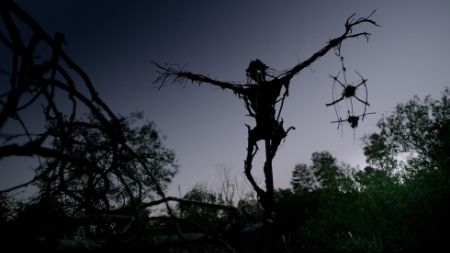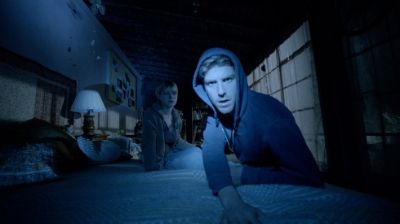
If considering the film as a kind of journey, it is pretty
amazing to think where MR. JONES, a new and unique horror film from director
Karl Mueller, begins and the far off place where it ends.
It starts out with camcorder footage capturing a couple, Scott
and Penny, enjoying a carefree drive through desert terrain. Their dialogue is much like the cutesy
cleverness of a car commercial, as they show total awareness that they are narrating
an experience that could become an object of public viewing.
They arrive at a cabin where they intend to stay so that
Scott, an aspiring filmmaker, can complete a nature documentary. However, the sunny skies grow darker after little time, hinting early on about the film’s
shape shifting nature. Scott’s voiceover monologues reveal that his
artistic vision is far from clear; it’s something he hopes will take shape once
inspired by the location they have removed themselves too. Penny is
growing frustrated with Scott’s lack of progress, and there are allusions
to some kind of psychological condition that
Scott has had to deal with in the past. There is also the issue of him deciding to go off
his medication.
As unrest persists, a mysterious figure reveals himself. It
is a harbinger of both terror and hope. While ominous occurrences begin cropping up around his appearance, they
determine that the desert dweller is Mr. Jones, an artist known in the public
sphere, but only through mysterious stories and conjecture. There are no known
facts about the man, who seems the stuff of urban legend, and traces of him
have been found solely in totem like art pieces attributed to his hands. Their
discovery of Mr. Jones is the jumping off point of the film’s journey,
following the development of a documentary about the artist and the couple’s
encounter with him, bringing them slowly closer to his true nature.
While it is fascinating to consider the start and end points
of the film, Mueller’s direction of the trip as it unfolds can be a rough and
at times confounding ride. A critique I have noticed among reactions to the film is
that its story would have been far more successful if not shot in the style of
found footage. It’s a notion I’ve tried to avoid discussing, not because I
disagree – it is in fact an accurate assessment – but as a result of it coming up
so often in reaction to this and other movies. Perhaps for this reason, I
resigned myself to the fact that this is an exercise in that divisive genre, and focused my thinking on whether or not the story was suited
the format.
At first it absolutely ia; the jarring thud of at first
unidentifiable objects against the windows of a remote cabin at dusk is a chill
best experienced with a greater element of reality attached. Same can be said
for Mr. Jones’ first inscrutable appearances. But the part of the story in
which it serves best, and the most exciting part of the film to me, is the
documentary in progress we see being made in New York, after the couple
concludes Mr. Jones is their not quite next door neighbor. It is another odd
move that makes for a total shift in gears. And moods – any sense of dread and
horror is left behind for something completely different.
Suddenly we are in the world of pseudo-documentary as art
historians, anthropologists, and regular citizens who have had unsettling
encounters with Mr. Jones’ work offer perspectives on the mysterious being, of
whom little fact is known. This artificial construction of a mythology,
complete with fictionalized experts, is quietly thrilling in the way it blurs the
lines of reality. While never quite suggesting it's real, it is easily the part
of the film most readily confusable with actual documentary footage. It’s the
stuff of art pranksters, making the mention of Banksy as Scott and Penny piece
together their initial knowledge of Mr. Jones seem like it may just be a little
more than coincidence?
Clearly I wish this part of the film continued much longer. It
gets even more convoluted when you consider there is a real life artist
responsible for the sculptures attributed to Mr. Jones. He creates under the
moniker Pumpkin Rot. There is a doubling here, in the real world and the world
on film, of figures with veiled identities. Are the works in the film more Pumpkin
Rot or Mr. Jones? Do the ritualistic qualities of their arrangement in the film
represent the real artist’s work, or is he just doing a job…The possibilities
are fascinating to explore, and more layers added to the mythology, through
mock interviews and realistic footage, would have been welcome.
In a sense, it is continued. By way of a return to Mr.
Jones’ domain. Yet, while further scenes of research and explorations of the
artist’s turf might have matched the camcorder style of shooting, the very surreal
turn that the action takes does not. A great many ideas come out of the screen
suggesting various possibilities about Jones: Suggestions that there are
different layers of reality that he moves between, that he could be either an
embodiment of evil or a protecting force, are explored. Recorded footage blurs
together with events that are taking place, and multiple images of characters
appear. If the ending shows what I believe it might be, then it is an amazing
trip from beginning to end, indeed.
But the ‘if’ in that equation is the problem at large. So
scattered are the visuals, there is more of a sense of disorganization than
mystique. It becomes something quite difficult to follow and causes more
frustration than curiosity.
Returning to consider the criticisms of the film’s visual
style, I realize that I have been more tolerant of similarly disjointed
narratives when they’ve blown me away with bold visuals. Indeed films that are
open to interpretation have a great value, but they need stronger images, and a
stronger connection between images, to make the forming of conclusions feel
worthwhile.
MR. JONES received its world premiere screening at the 2013 Tribeca Film Festival. Release rights to the film have been purchased by Anchor Bay.
Tweet-tivity = @mondocurry

No comments:
Post a Comment